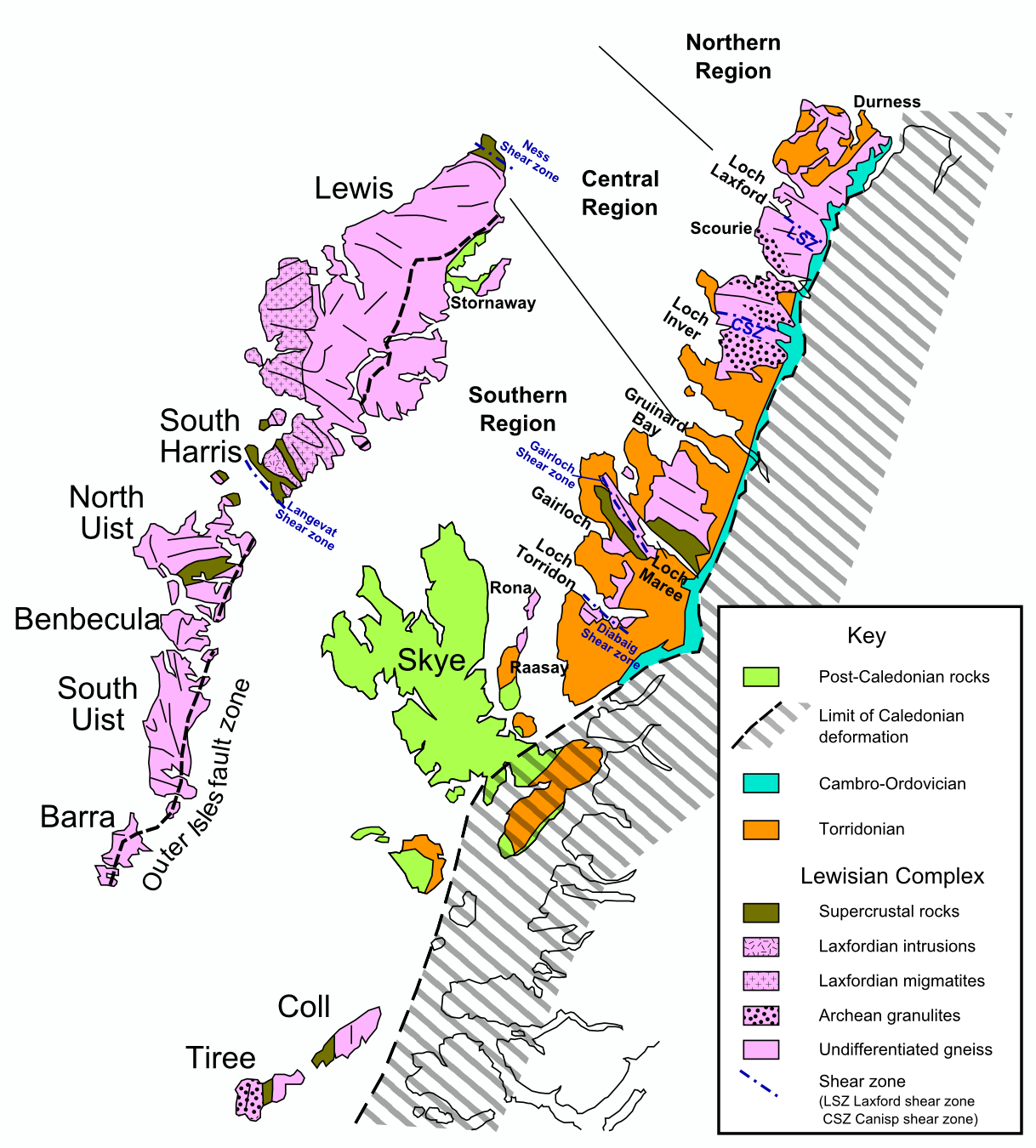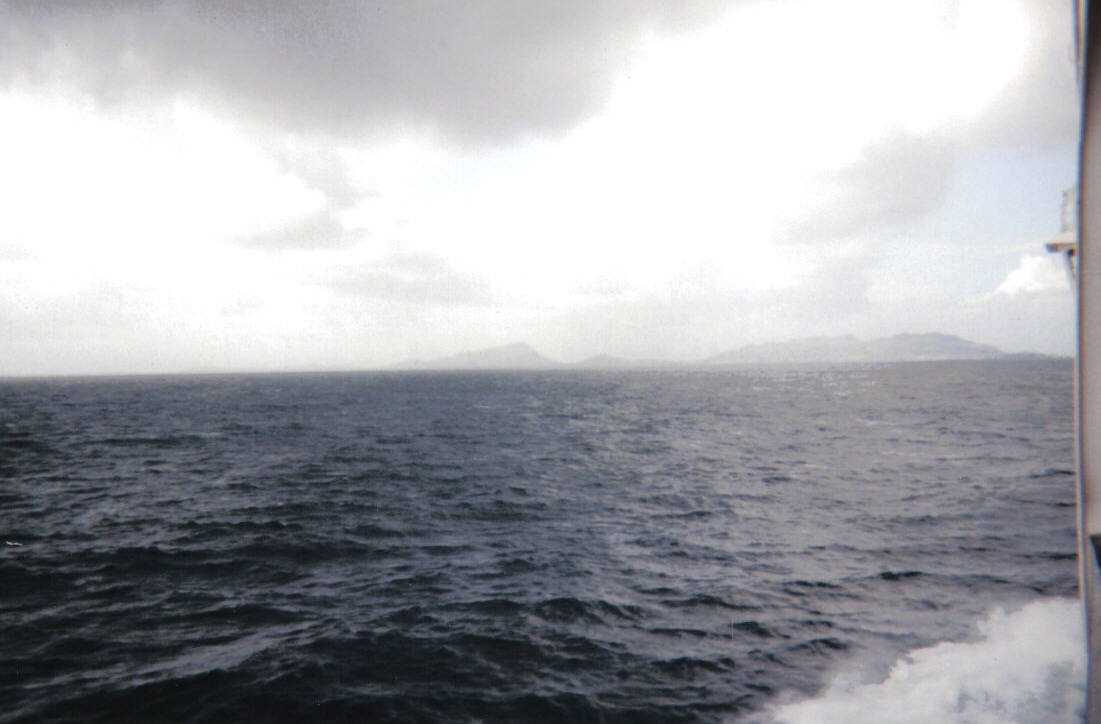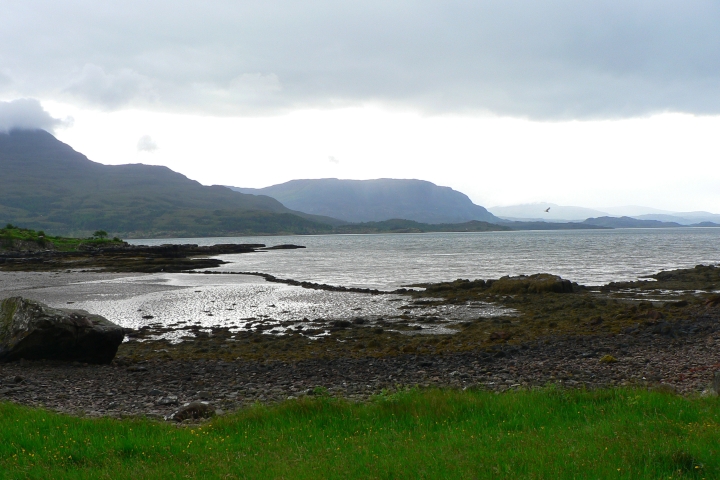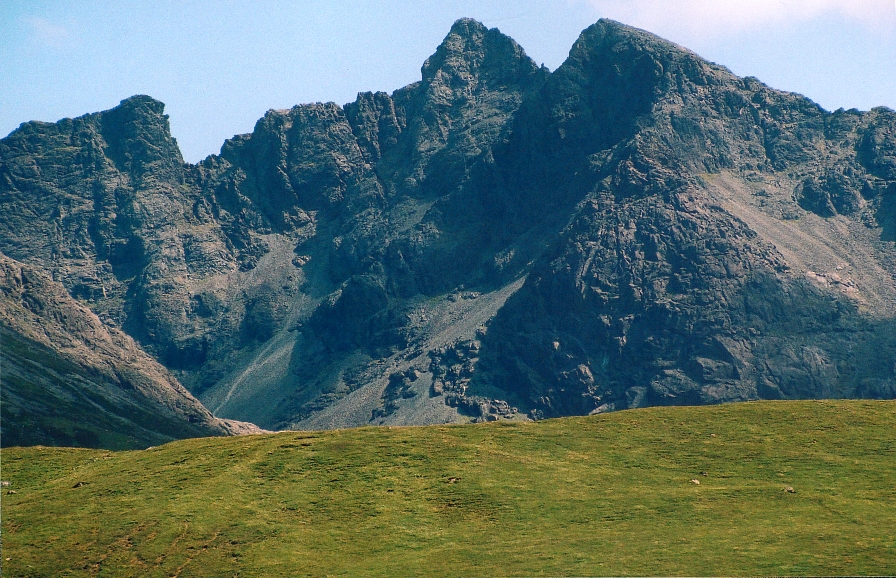|
Lewisian Complex
The Lewisian complex or Lewisian gneiss is a suite of Precambrian metamorphic rocks that outcrop in the northwestern part of Scotland, forming part of the Hebridean terrane and the North Atlantic craton, North Atlantic Craton. These rocks are of Archean, Archaean and Paleoproterozoic age, ranging from 3.0–1.7 billion years (Year#SI prefix multipliers, Ga). They form the Basement (geology), basement on which the Stoer Group, Wester Ross Supergroup and probably the Loch Ness Supergroup sediments were deposited. The Lewisian consists mainly of Granite, granitic gneisses with a minor amount of supracrustal rocks. Rocks of the Lewisian complex were caught up in the Caledonian orogeny, appearing in the hanging walls of many of the thrust faults formed during the late stages of this tectonic event. Distribution The main outcrops of the Lewisian complex are on the islands of the Outer Hebrides, including Isle of Lewis, Lewis, from which the complex takes its name. It is also exp ... [...More Info...] [...Related Items...] OR: [Wikipedia] [Google] [Baidu] |
Caledonian Orogeny
The Caledonian orogeny was a mountain-building cycle recorded in the northern parts of the British Isles, the Scandinavian Caledonides, Svalbard, eastern Greenland and parts of north-central Europe. The Caledonian orogeny encompasses events that occurred from the Ordovician to Early Devonian, roughly 490–390 million years ago ( Ma). It was caused by the closure of the Iapetus Ocean when the Laurentia and Baltica continents and the Avalonia microcontinent collided. The orogeny is named for Caledonia, the Latin name for Scotland. The term was first used in 1885 by Austrian geologist Eduard Suess for an episode of mountain building in northern Europe that predated the Devonian period. Geologists like Émile Haug and Hans Stille saw the Caledonian event as one of several episodic phases of mountain building that had occurred during Earth's history.McKerrow ''et al.'' (2002) Current understanding has it that the Caledonian orogeny encompasses a number of tectonic phases th ... [...More Info...] [...Related Items...] OR: [Wikipedia] [Google] [Baidu] |
Hydrocarbon Exploration
Hydrocarbon exploration (or oil and gas exploration) is the search by petroleum geologists and geophysicists for hydrocarbon deposits, particularly petroleum and natural gas, in the Earth's crust using petroleum geology. Exploration methods Visible surface features such as oil seeps, natural gas seeps, pockmarks (underwater craters caused by escaping gas) provide basic evidence of hydrocarbon generation (be it shallow or deep in the Earth). However, most exploration depends on highly sophisticated technology to detect and determine the extent of these deposits using exploration geophysics. Areas thought to contain hydrocarbons are initially subjected to a gravity survey, magnetic survey, passive seismic or regional seismic reflection surveys to detect large-scale features of the sub-surface geology. Features of interest (known as ''leads'') are subjected to more detailed seismic surveys which work on the principle of the time it takes for reflected sound waves to travel ... [...More Info...] [...Related Items...] OR: [Wikipedia] [Google] [Baidu] |
Sea Of The Hebrides
The Sea of the Hebrides (, ) is a small and partly sheltered section of the North Atlantic Ocean, indirectly off the southern part of the north-west coast of Scotland. To the east are the mainland of Scotland and the northern Inner Hebrides (including Skye and the Small Isles); to the west are the southern Outer Hebrides islands, principally South Uist, Eriskay, and Barra. To the north is the Little Minch, a channel connecting it with the Minch. The Sea of the Hebrides forms part of the Inner Seas off the West Coast of Scotland, as defined by the International Hydrographic Organization, and part of the Seas west of Scotland as far as fisheries management is concerned. Ending on 30 August 2019, the Scottish Government consulted on a proposal to designate the Sea of the Hebrides a Marine Protected Area (MPA). The designation was confirmed in December 2020. The designated area of the MPA covers , mainly to protect the area's population of basking sharks The basking shar ... [...More Info...] [...Related Items...] OR: [Wikipedia] [Google] [Baidu] |
Minches
The Minch () is a strait in north-west Scotland that separates the mainland from Lewis and Harris in the Outer Hebrides. It was known as ("Scotland's firth") in Old Norse. The Minch's southern extension, which separates Skye from the middle islands of the Hebridean chain, is known as the Little Minch. It opens into the Sea of the Hebrides. Geography The Minch and Little Minch form part of the Inner Seas off the West Coast of Scotland, as defined by the International Hydrographic Organization. The Minch ranges from wide and is approximately long. It is believed to be the site of the biggest meteorite ever to hit the British Isles. The Little Minch is about wide. In June 2010 Eilidh Macdonald became the first person to swim across it from Waternish Point on Skye to Rodel on Harris, in a time of hours. Navigation A traffic separation scheme operates in the Little Minch, with northbound traffic proceeding close to Skye, and southbound close to Harris. Commercial ferry ... [...More Info...] [...Related Items...] OR: [Wikipedia] [Google] [Baidu] |
Shetland
Shetland (until 1975 spelled Zetland), also called the Shetland Islands, is an archipelago in Scotland lying between Orkney, the Faroe Islands, and Norway, marking the northernmost region of the United Kingdom. The islands lie about to the northeast of Orkney, from mainland Scotland and west of Norway. They form part of the border between the Atlantic Ocean to the west and the North Sea to the east. The island's area is and the population totalled in . The islands comprise the Shetland (Scottish Parliament constituency), Shetland constituency of the Scottish Parliament. The islands' administrative centre, largest settlement and only burgh is Lerwick, which has been the capital of Shetland since 1708, before which time the capital was Scalloway. Due to its location it is accessible only by ferry or flight with an airport located in Sumburgh as well as a port and emergency airstrip in Lerwick. The archipelago has an oceanic climate, complex geology, rugged coastline, and m ... [...More Info...] [...Related Items...] OR: [Wikipedia] [Google] [Baidu] |
Cape Wrath
Cape Wrath (, known as ' in Lewis) is a cape in the Durness parish of the county of Sutherland in the Highlands of Scotland. It is the most north-westerly point in Great Britain. The cape is separated from the rest of the mainland by the Kyle of Durness and consists of of moorland wilderness known as the Parph. The first road was built in 1828 by the lighthouse commission across the Parph/Durness. This road connects a passenger ferry that crosses the Kyle of Durness with the buildings on the peninsula. Much of the cape is owned by the Ministry of Defence and is used as a military training area, including as live firing range. Areas of it are also designated as a Site of Special Scientific Interest, a Special Protection Area, a Special Area of Conservation and a Special Landscape Area. Etymology The name Cape Wrath is derived from Old Norse ' ("turning point"), accordingly, ''wrath'' is pronounced (''a'' as in ''cat''). [...More Info...] [...Related Items...] OR: [Wikipedia] [Google] [Baidu] |
Loch Torridon
Loch Torridon () is a sea loch on the west coast of Scotland in the Northwest Highlands. The loch was created by glacial processes and is in total around 15 miles (25 km) long. It has two sections: Upper Loch Torridon to landward, east of Rubha na h-Airde Ghlaise, at which point it joins Loch Sheildaig; and the main western section of Loch Torridon proper. Loch a' Chracaich and Loch Beag are small inlets on the southern shores of the outer Loch, which joins the Inner Sound, Scotland, Inner Sound between the headlands of Rubha na Fearna to the south and Red Point to the north. The name ''Thoirbhearta'' has a similar root to ''Tarbert'' and indicates a place where boats were dragged overland. Islands The islets in the loch include: * in Loch Shieldaig: Eilean an Inbhire Bhàin, Eilean Dùghaill and Shieldaig Island. * in Upper Loch Torridon: Eilean à Chaoil, Eilean Cnapach, both of which are tidal. * in outer Loch Torridon: Eilean Mòr, Loch Torridon, Eilean Mòr, Eilean Tior ... [...More Info...] [...Related Items...] OR: [Wikipedia] [Google] [Baidu] |
Inner Hebrides
The Inner Hebrides ( ; ) is an archipelago off the west coast of mainland Scotland, to the south east of the Outer Hebrides. Together these two island chains form the Hebrides, which experience a mild oceanic climate. The Inner Hebrides comprise 35 inhabited islands as well as 44 uninhabited islands with an area greater than . Skye, Isle of Mull, Mull, and Islay are the three largest, and also have the highest populations. The main commercial activities are tourism, crofting, fishing and Scotch whisky, whisky distilling. In modern times the Inner Hebrides have formed part of two separate local government jurisdictions, one to the north and the other to the south. Together, the islands have an area of about , and had a population of 18,948 in 2011. The population density is therefore about . There are various important prehistoric structures, many of which pre-date the first written references to the islands by Classical antiquity, Roman and Greek authors. In the historic period ... [...More Info...] [...Related Items...] OR: [Wikipedia] [Google] [Baidu] |
Isle Of Lewis
The Isle of Lewis () or simply Lewis () is the northern part of Lewis and Harris, the largest island of the Western Isles or Outer Hebrides archipelago in Scotland. The two parts are frequently referred to as if they were separate islands. The total area of Lewis is . Lewis is, in general, the lower-lying part of the island: the other part, Harris, Outer Hebrides, Harris, is more mountainous. Due to its larger area and flatter, more fertile land, Lewis contains three-quarters of the population of the Western Isles, and the largest settlement, Stornoway. The island's diverse habitats are home to an assortment of flora and fauna, such as the golden eagle, red deer and Pinniped, seal, and are recognised in a number of Conservation area (United Kingdom), conservation areas. Lewis has a Presbyterian tradition and a rich history. It was once part of the Norsemen, Norse Kingdom of the Isles. Today, life is very different from elsewhere in Scotland, with Sabbath in Christianity, Sabbath ... [...More Info...] [...Related Items...] OR: [Wikipedia] [Google] [Baidu] |
Outer Hebrides
The Outer Hebrides ( ) or Western Isles ( , or ), sometimes known as the Long Isle or Long Island (), is an Archipelago, island chain off the west coast of mainland Scotland. It is the longest archipelago in the British Isles. The islands form part of the archipelago of the Hebrides, separated from the Scottish mainland and from the Inner Hebrides by the waters of the Minch, the Little Minch, and the Sea of the Hebrides. The Outer Hebrides are considered to be the traditional heartland of the Gaelic language. The islands form one of the 32 council areas of Scotland, which since 1998 has used only the Gaelic form of its name, including in English language contexts. The council area is called Na h-Eileanan an Iar ('the Western Isles') and its council is ('Council of the Western Isles'). Most of the islands have a bedrock formed from ancient metamorphic rocks, and the climate is mild and oceanic. The 15 inhabited islands had a total population of in and there are more th ... [...More Info...] [...Related Items...] OR: [Wikipedia] [Google] [Baidu] |
Road Cutting - Geograph
A road is a thoroughfare used primarily for movement of traffic. Roads differ from streets, whose primary use is local access. They also differ from stroads, which combine the features of streets and roads. Most modern roads are paved. The words "road" and "street" are commonly considered to be interchangeable, but the distinction is important in urban design. There are many types of roads, including parkways, avenues, controlled-access highways (freeways, motorways, and expressways), tollways, interstates, highways, and local roads. The primary features of roads include lanes, sidewalks (pavement), roadways (carriageways), medians, shoulders, verges, bike paths (cycle paths), and shared-use paths. Definitions Historically, many roads were simply recognizable routes without any formal construction or some maintenance. The Organization for Economic Co-operation and Development (OECD) defines a road as "a line of communication (travelled way) using a stabilized base other ... [...More Info...] [...Related Items...] OR: [Wikipedia] [Google] [Baidu] |








